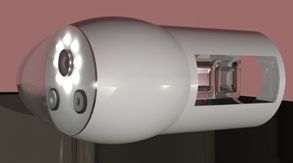Researchers Using MRI to Drive Pill Camera
Researchers at Brigham and Women’s Hospital and Tel Aviv University have built a tiny pill camera that would be powered and maneuvered by MRI.
The MRI machine will soon be able to do more than just imaging. It will be able to power and maneuver a tiny pill camera inside the digestive tract.
As a diagnostic tool, these cameras, known as capsule endoscopes, can provide wireless photos and videos of the digestive tract. Although the cameras exist today, there is no way to control them as they move through the body, and no way to let diagnosticians point the camera at specific areas or mark where the photos were taken.
That will soon change, because of technology developed by researchers at Brigham and Women’s Hospital and Tel Aviv University, which was just published in the journal Biomedical Microdevices.
So far, the mechanism has been tested only in an aquarium inside an MRI machine, but researchers have no reason to believe it will function differently in the body.
Diagnostic Imaging spoke with principal investigator Noby Hata, PhD, an associate professor of radiology at Brigham and Woman’s Hospital.
How does it work?
The current capsule endoscope doesn’t swim. One of the problems is that there is no way for it to go back to where you find the disease, or to stop and make a treatment, because it steers itself. Our contribution is that we made the capsule swim. It’s self-propelling, using MRI.

How is the capsule endoscope maneuvered?
You have to use a lot of water. That helps the steering. Ours also uses MRI which is available anywhere in the world.
How is power generated in the capsule?
Wires generate the power. We use the MRI for not only propulsion force energy, but wireless energy generation. You can do that because the MRI has a radio frequency pulse, a big strong magnetic field, using radio frequency signal. We can use that signal for power generation.
How does the tail motion work?
My collaborator [Dr. Gabor Kosa] has done an interesting study of human sperm. He duplicated the propulsion force with his own version of a mechanical tail. He made it happen without MRI, with its own coil and tail. I thought that this could be done with MRI because of the strong magnetic field. If you put together three coils in the tail [using copper coil and flexible polymer], you can produce a force in such a way that these three coils would make a tail motion.
Isn’t it a problem to use metal in an MRI machine?
That’s a myth. People are afraid of putting metal in an MRI. With careful consideration and design, in the size and mass, you can do it.
How does your capsule differ from others?
I wanted to use MRI to make it swim in the water, but also to image the body and see where this thing is. That’s the beauty of it. You can use it to image where the capsule is, which is not possible in today’s capsule endoscope - you never know where they are in the body. You don’t want to make the capsule endoscope MRI-friendly because it would make it invisible in the MRI. I chose a light material so it would swim and appear in the MRI. It appears in MRI like a little blackish dot, which is important because we can tell where it is, surrounded by organs. You can take MRI images at the same time. The capsule is like a GPS, which lets you know where you are microscopically. You can mark your location on the map and come back to do treatment later.
What photos would be taken?
It would be based on what capsule endoscope does today: video or periodic snapshots.
Where is your capsule endoscope in the development stage?
We have to miniaturize it. That’s a must. It’s about twice the size of today’s capsule because of the tail. Our concept is to have the tail in the endoscope. Right now it’s basically the tail floating in the water, with the controls and circuits above.
We really want a commercial partner. They can provide a complementary knowledge and skill. I can’t do the miniaturization. Within a year, I see it happening. We’re getting a lot of interest.
What other research is happening with capsule endoscopes?
Many people are trying to do the swimming capsule endoscope. One Japanese investigator swallowed his own swimming endoscope and could steer it. It wasn’t published, but there’s news media coverage. They used special magnet or device to be attached or placed around the patient and that magnet pulled the capsule toward the desired direction. There are other reports of researchers encapsulating the magnet - same concept.
"This video shows an actual test of the mechanisms of the Swimming Endoscopic Capsule. The test is conducted in a tank of water inside an MRI machine. The test proves that the capsule can be manipulated using the magnetic forces of an MRI machine."
Photos and videos courtesy Brigham and Women’s Hospital
Study: Monitoring of Prostate MRI Exams Could Lead to 75 Percent Reduction of Gadolinium Contrast
March 17th 2025While DCE MRI was deemed helpful in over 67 percent of cases in which it was used, researchers found that monitored prostate MRI exams, which facilitated a 75 percent reduction of DCE MRI sequences, had comparable sensitivity for prostate cancer as non-monitored exams.